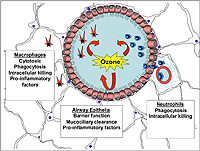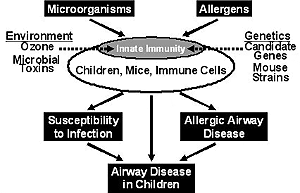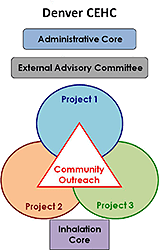Children's Environmental Health Center

The theme of the Denver Children's Environmental Health Center (CEHC) is to investigate the etiology and pathogenesis of airway disease in children. We chose this theme for our program for the following reasons:
Asthma and other forms of airway disease/illness are the most common chronic illnesses in children.
The environment results in unique combinations of exposures to children that affect lung immunity and consequently alters the risk of developing airway disease.
Environmental models of airway disease provide an ideal opportunity to investigate basic mechanisms involved in the development of childhood airway disease such as the basic immunology and persistence of airway disease.
This theme builds on existing scientific expertise and relationships with community stakeholders and members to ensure a highly interactive program.

Since ozone and endotoxin are common environmental exposures, and both of these agents have been demonstrated to have immune modulating affects (Figures 1 and 2), we have decided to use these very relevant environmental exposures to further focus the projects in our proposed program. The end result is a highly integrated and focused Center that has the potential to make a number of novel, related observations. In aggregate, the coupled scientific findings from the proposed program will substantially enhance our understanding of airway disease in children that can be immediately translated to communities in Colorado.
The overarching hypothesis that unifies this research program is that lung host defense and lung immunity are dynamic biologically, are affected by ozone and endotoxin, and that this dynamic biology can alter susceptibility to agents known to cause airway disease in children (Figure 3).
We believe that understanding the basic and translational aspects of this hypothesis will provide the scientific rationale to develop primary, secondary and tertiary prevention programs that reduce the morbidity and mortality of childhood airway disease/illneses.

Our Project-specific Hypotheses
 Project 1 : Higher levels of endotoxin exposure cause persistent, problematic asthma and that key environmental (ozone and allergens) and genetic modifiers (endotoxin receptor polymorphisms) contribute to endotoxin susceptibility and pathological asthmatic responses.
Project 1 : Higher levels of endotoxin exposure cause persistent, problematic asthma and that key environmental (ozone and allergens) and genetic modifiers (endotoxin receptor polymorphisms) contribute to endotoxin susceptibility and pathological asthmatic responses.
Project 2: Ozone exposure in the early postnatal phase alters lung development and modifies the host immune response to early life viral infection and allergen exposure, thereby contributing to the development of reactive airway disease.
Project 3: Expression of toll-like receptors (TLRs) in the lung are influenced by environmental (ozone and/or PAMPs) and genetic factors, and the dynamic expression of TLRs has profound effects on lung host defense and consequently the development of lung infections and allergic airway disease. Community Outreach and Translation Core: This core serves as a forum for dialoguing and exchanging information among investigators, practitioners, and community stakeholders regarding the activities of the Children’s Health and Environment Center. The overarching hypothesis of this core is that a community-based outreach program can effectively educate children to modify environmental exposures that cause respiratory illnesses and associated morbidity.
